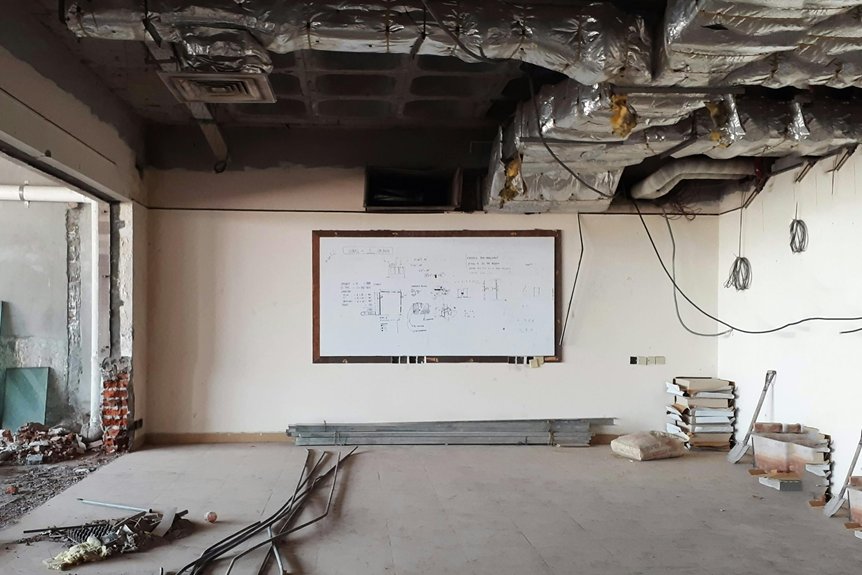There are several common types of insulation used in buildings, including fibrous materials such as fibreglass, rock wool, and natural fibres that trap air, providing effective thermal resistance. Cellular options like foam and plastic, including spray foam and foam boards, are lightweight and offer high R-values.
Loose-fill insulation, crafted from recycled cellulose or fibreglass, easily fills irregular spaces, while batts provide straightforward installation in standard areas. Rigid board insulation is known for its durability, moisture resistance, and high thermal performance.
Exploring these options reveals how they can significantly enhance energy efficiency in various settings, catering to different needs and preferences.
Fibrous Insulation Materials
Fibrous insulation materials are a popular choice for maintaining temperature control in buildings, thanks to their capacity to trap air within fine fibres. This characteristic effectively reduces heat transfer by inhibiting convection and minimising heat conduction between gas molecules. These materials are crafted from small diameter fibres, including glass, rock wool, or alumina silica. Available in various forms such as batts, rolls, or loose-fill, fibrous insulation offers flexibility for installation in diverse spaces. Valued for their adaptability, soundproofing properties, and thermal insulation performance, fibrous insulations are also regarded as environmentally friendly. Many options contain recycled content, with certain types incorporating significant proportions of recycled materials. Fibrous insulation materials are also resistant to moisture, which helps prevent mold growth and maintains their insulating efficiency over time. This combination of features makes fibrous insulation a reliable and sustainable choice for both residential and commercial properties across the UK.
Cellular Insulation (Foam & Plastic-Based)
Cellular insulation, composed of foam and plastic-based materials, provides a distinct form of thermal resistance when compared to fibrous alternatives. This type of insulation includes both open-cell and closed-cell foams, which vary in structure and moisture absorption properties. It is also lightweight and easy to install, making it a popular choice among builders and homeowners. main factual point Open-cell foam comprises less than 90% sealed cells, resulting in greater permeability to moisture and air. This makes it particularly suitable for interior applications and soundproofing purposes. In contrast, closed-cell foam features over 90% sealed cells, which contributes to its higher R-values, minimal water absorption, and function as a vapour barrier. This foam is denser and more rigid, offering enhanced strength and durability. Common varieties include spray foam and foam board, each tailored to meet specific insulation needs. Closed-cell foam is effective at resisting moisture and air leakage, while open-cell foam is more flexible and breathable. This versatility makes cellular insulation an excellent choice for a wide range of projects across the UK.
Loose-Fill, Bat, and Rigid Board Insulation
Loose-fill insulation comprises materials such as cellulose, fibreglass, and rock wool. It’s ideal for quickly and cost-effectively filling irregular spaces, making it a versatile option for many homes. Additionally, loose-fill insulation is often made from recycled materials, contributing to its environmentally friendly appeal, while also assisting in energy conservation by maintaining consistent indoor temperatures. Its installation typically involves drilling holes into wall cavities and blowing in the material, making it suitable for retrofitting existing structures. Commonly used in attics and walls, loose-fill insulation can improve a building’s overall thermal performance efficiently.
Bat insulation, constructed from fibreglass, rock wool, or natural fibres, is straightforward to install in standard spaces.
However, it may be less adaptable for areas that are irregularly shaped, which can limit its application in certain settings.
Rigid board insulation offers high thermal resistance (R-values) per inch, ensuring effective insulation.
It’s known for its durability and resistance to moisture and pests, although it requires precise installation to achieve optimal performance.
Conclusion
Different types of insulation cater to various needs, ranging from fibrous materials like fibreglass to cellular options such as foam and plastics. Loose-fill, bat, and rigid board insulations each offer unique advantages, making them suitable for specific applications.
Understanding these options assists homeowners and builders in selecting the right insulation to enhance energy efficiency and comfort. By carefully choosing the appropriate type, one can ensure better temperature control, reduced energy costs, and increased durability in building structures.

